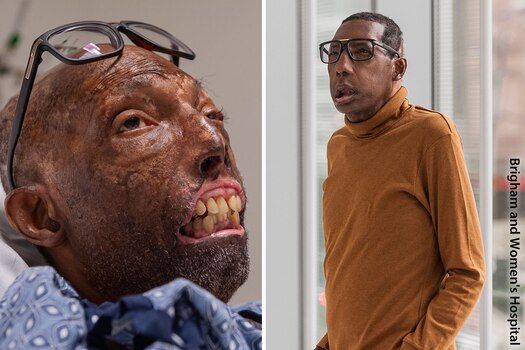Chelsea, 68, is also the oldest face transplant patient. He’s one of just 15 recipients in the United States, out of around 40 worldwide done since 2005.
“May God bless the donor and his family who chose to donate this precious gift and give me a second chance,” Chelsea said in a statement. “Words cannot describe how I feel. I am overwhelmed with gratitude and feel very blessed to receive such an amazing gift.”

According to the hospital, Chelsea “is likely to achieve near normal sensation and about 60 percent restoration of facial motor function within a year, including the ability to eat, smile and speak normally.” His was the ninth face transplant procedure done at Brigham and Women’s Hospital.
“The face symbolically is such an important part of our bodies, to some people it’s almost who we are,” says Jerry McCauley, MD, chief of nephrology at Thomas Jefferson University Hospital and former chairman of minority affairs at the United Network of Organ Sharing (UNOS). “African Americans have a wide variety of skin colors, so there could be a major difference. When you’re doing cosmetic transplants you want to match as closely as you can: What will my lips look like, my nose? Will I resemble people in my family?”
Until recently, African Americans were less likely than white people to receive transplants of any kind. At one point, they waited almost three times as long, McCauley says. In 2015, UNOS rolled out a new allocation system that removed much of the systemic bias. Today, the wait time for kidneys is approximately the same for both races, though there’s still a disparity among heart and lungrecipients.
According to Organdonor.gov, African Americans make up nearly 30% of the wait list for transplants, compared to almost 41% for white people — yet African Americans only receive about 21% of transplants, while white people get more than 55%. Black people make up around 13% of the U.S. population.
“That may have to do with physician selection, socioeconomics, even where you’re being evaluated,” says McCauley. “And the final issue may be the discrimination factor that nobody likes to talk about.”
For many years, there was also a substantial racial disparity in the number of donors. Distrust of the medical system, certain religious beliefs, and other concerns kept many black people from donating. In 1988, for example, there were only 359 African American deceased donors. Because of a joint effort to increase donations, by 2018, that number had surpassed 7,000. The percentage of donors who are black now reflects their percentage in the population, even though allocation of organs remains uneven.
When it comes to organs and non-cosmetic transplants, race isn’t a factor — we’re all the same beneath the skin. But body parts like the face, hands, and reproductive organs require composite tissue transplants. Those take multiple tissue types, including skin, bones, nerves, and blood vessels, and when skin is involved, appearances count. Thanks to the increased rate of donation among African Americans, the larger pool of skin tone matches may have helped bring about Chelsea’s transplant, McCauley says.
“It’s going to be exciting,” says McCauley. “Other African Americans will see this gentleman and know this is for them, too. You don’t have to worry about getting a transplant with a white face. You can have a face that makes sense for you.”









